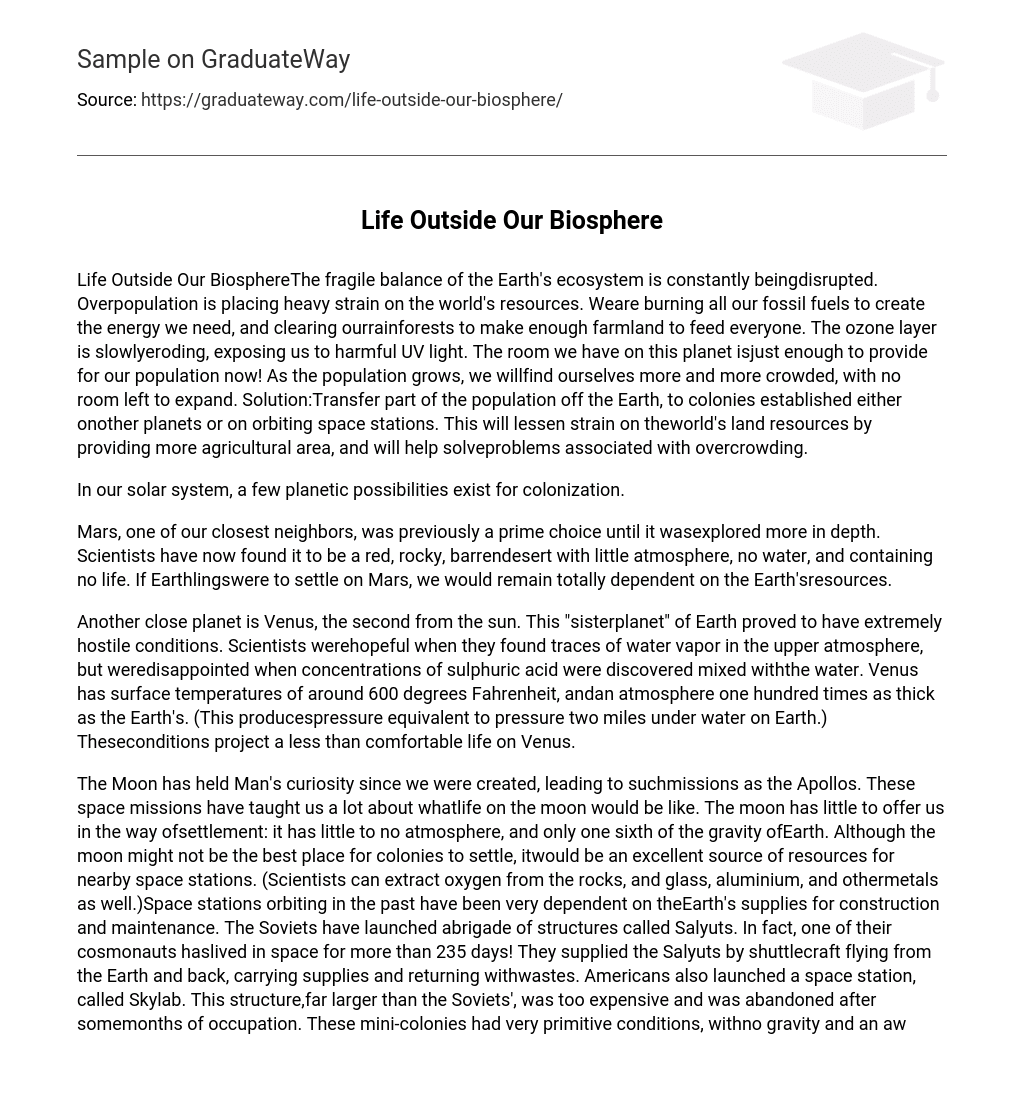Life Outside Our BiosphereThe fragile balance of the Earth’s ecosystem is constantly beingdisrupted. Overpopulation is placing heavy strain on the world’s resources. Weare burning all our fossil fuels to create the energy we need, and clearing ourrainforests to make enough farmland to feed everyone. The ozone layer is slowlyeroding, exposing us to harmful UV light. The room we have on this planet isjust enough to provide for our population now! As the population grows, we willfind ourselves more and more crowded, with no room left to expand. Solution:Transfer part of the population off the Earth, to colonies established either onother planets or on orbiting space stations. This will lessen strain on theworld’s land resources by providing more agricultural area, and will help solveproblems associated with overcrowding.
In our solar system, a few planetic possibilities exist for colonization.
Mars, one of our closest neighbors, was previously a prime choice until it wasexplored more in depth. Scientists have now found it to be a red, rocky, barrendesert with little atmosphere, no water, and containing no life. If Earthlingswere to settle on Mars, we would remain totally dependent on the Earth’sresources.
Another close planet is Venus, the second from the sun. This “sisterplanet” of Earth proved to have extremely hostile conditions. Scientists werehopeful when they found traces of water vapor in the upper atmosphere, but weredisappointed when concentrations of sulphuric acid were discovered mixed withthe water. Venus has surface temperatures of around 600 degrees Fahrenheit, andan atmosphere one hundred times as thick as the Earth’s. (This producespressure equivalent to pressure two miles under water on Earth.) Theseconditions project a less than comfortable life on Venus.
The Moon has held Man’s curiosity since we were created, leading to suchmissions as the Apollos. These space missions have taught us a lot about whatlife on the moon would be like. The moon has little to offer us in the way ofsettlement: it has little to no atmosphere, and only one sixth of the gravity ofEarth. Although the moon might not be the best place for colonies to settle, itwould be an excellent source of resources for nearby space stations. (Scientists can extract oxygen from the rocks, and glass, aluminium, and othermetals as well.)Space stations orbiting in the past have been very dependent on theEarth’s supplies for construction and maintenance. The Soviets have launched abrigade of structures called Salyuts. In fact, one of their cosmonauts haslived in space for more than 235 days! They supplied the Salyuts by shuttlecraft flying from the Earth and back, carrying supplies and returning withwastes. Americans also launched a space station, called Skylab. This structure,far larger than the Soviets’, was too expensive and was abandoned after somemonths of occupation. These mini-colonies had very primitive conditions, withno gravity and an awkward lifestyle.
Scientists predict that space colonies of the future will be muchdifferent from these first primitive attempts, but knowing which design theywill adopt is difficult. Most engineers agree that they will be in a roundconfiguration, slowly rotating, causing centrifugal force with effects like theEarth’s gravity. Some experts believe that colonies will eventually be around200 km2, with some large enough to house one million people. Because the colonywill be environmentally controlled, natural disasters will be almost obsolete.
The only things to worry about will be asteroid showers, which only occur aboutevery one thousand years. Factories and other industrial facilities will benearby, along with the greenhouses.
One of the biggest benefits of these space stations is the excellentagricultural potential. The orbiting space station is constantly exposed to thesun’s rays, and 24 hours a day of photosynthesis in a greenhouse could give thecolony all the food and oxygen it could need. If some of these resources couldbe sent back to Earth, less arable land would be ruined by over farming forstarving people. Massive amounts of energy in the universe are unused, andsolar panels constantly exposed to unfiltered sunlight may harvest some of thisenergy. Huge solar panels attached to the station could provide for all of itsenergy needs, leaving extra to provide for those still on Earth.
The construction of space stations will be a compilation of resourcesfrom across the solar system. Initially, we will obtain much of the materialfrom Earth, but we have other sources available to us. Rock, glass, metal, andoxygen taken from the moon would be better than if it were taken from the Earth,because the moon has such low gravity. Our planet has very strong gravity, andremoving matter from our planet uses up a lot of energy. Removing metals androck from the moon is relatively easy, however. Water is another element vitalto the survival of future colonists, and some researchers suggest melting icefrom Saturn’s rings for this valuable resource.
Establishing settlements outside the biosphere we have lived in for solong will be very difficult. It will take cooperation from all the nations inthe world, at huge expense to the technologically advanced countries. We willalways be dependent on the Earth, and some primitive cultures may never leave it.
Colonization of outer space, however, is a good solution to the world’s energy,overpopulation, and agricultural problems.





